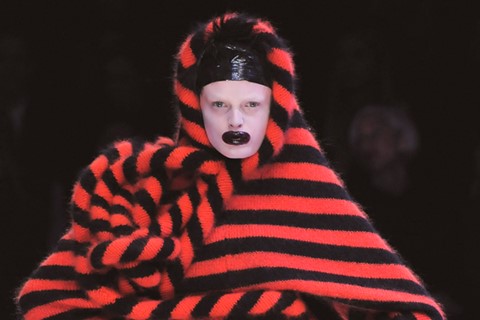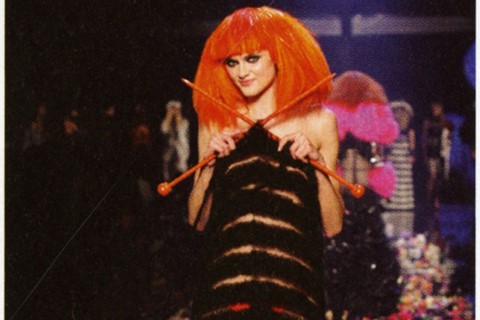With the current wave of young fashion designers creating statement collections heavy with knitwear, it could not be timelier for Antwerp’s Fashion Museum...
With the current wave of young fashion designers creating statement collections heavy with knitwear, it could not be timelier for Antwerp’s MoMu Fashion Museum to set up an exhibition that explores the richness and diversity of knitwear in fashion. Deceivingly, knitwear seems an unlikely suspect in the high-fashion world. Unravel: Knitwear in Fashion, counters the established idea of knitwear as old-fashioned and instead holds up an inspiring variety of knitted garments and accessories from the great fashion houses of the last centuries – Elsa Schiaparelli, Jean Patou and Chanel – up to contemporary designers and labels, including Sandra Backlund, Maison Martin Margiela and Mark Fast. The exhibition is a joint project of the MoMu and Emmanuelle Dirix, who is lecturer of Critical Issues at Winchester School of Art and also teaches at the Fashion Department of the Royal Academy of Fine Arts and at University of the Arts London. MoMu’s curator Karen Van Godtsenhoven sheds some light on the exhibition.
What gave the impetus for Unravel: Knitwear in Fashion?
Knitwear allows for a very individual execution of silhouette. If you look at Craig Lawrence versus Sandra Backlund versus Mark Fast, it becomes clear that there are vast differences in the way designers make use of knitting techniques. Also, starting from around 2006, there has been a steady return to raw materials and natural fabrics as opposed to synthetic jerseys. It fits the bigger picture of the emergence of eco-fashion and DIY fashion that is currently going strong. We now have young people knitting again – setting up knitting classes, writing knitting blogs and even ‘guerilla knitting’. We wanted to investigate this phenomenon and found that throughout history, knitting has consistently played a social role in revolutions. In the twenties it changed sports and stimulated emancipation, in the sixties the ‘youth quake’ reacted against the older generations’ couture with knitted clothing. And now, knitwear is part of another revolution: the slow fashion movement. Despite its many changes in status, knitwear has never really dissappeared. Its dynamism along with its renewed prominence made want to unravel knitwear’s importance in fashion.
How did you organise the exhibition?
As with every thematic MoMu exhibition we focused on presenting clothing silhouettes in installations, conceived in close conjunction with an artistic scenography meant to heighten the visual experience of the viewer. We used blow-ups of patterns and knitted details, produced by the Belgian textile family business Cousy, on the walls. As homage to Antwerp, the exhibition opens with three installations of Antwerp knitwear designers An Salens, Christian Wijnants and Hilde Frunt & Sigi. After this, we placed historic and contemporary pieces thematically, not chronologically. We’ve also used a few video fragments projected onto screens.
Why did you select the editorial image from AnOther Magazine S/S 2009 – Tilda Swinton wearing Sandra Backlund shot by Craig McDean – as the exhibition’s visual?
The image completely reflects knitwear’s artistic and idiosyncratic properties as a form of expression. The team that realized this stunning photograph are all extremely talented – the stylist Panos Yiapanis, the photographer Craig McDean, the actress Tilda Swinton’s extraordinary radiance; and of course Sandra Backlund, who created the dress, which is composed of four pieces, assembled especially for the occasion. It is a true high-fashion image but at the same time the silhouette is recognibably knitwear.
Sandra Backlund is a contemporary designer who could be considered an artist in her handling of knitwear. Does Unravel focus on the more conceptual instances of knitwear?
We tackle all angles. 3D, sculptural, deconstructed and surrealist fashion all pass in review, but so does ready-to-wear. The interplay between ‘high’ and ‘low’ fashion is important here. You’ll see how Schiaparelli assimilates a ‘quotidian’ nineteenth century bow in her surrealist trompe l’œil motifs, which became so well known that women would copy them at home. The effect is still widely used by many contemporary designers. The exhibition illustrates plenty of similar elements that were conceptual at first but became commonplace. Or the other way around, like sportswear inspired high fashion. The designer pieces are always shown in relation to ready-to-wear garments like cardigans, twinsets, socks and jumpers. The exhibition’s catalogue is a great read in this respect; its academic essays address the retro trend for example, and how elements like the Fair Isle motif come in and out of fashion. There are also amusing connections between knitwear and masculinity, as in Starsky’s brute cardigan worn in Starsky and Hutch. Knitwear and femininity’s relation has also changed, with the now dowdy twinset, which caused controversy when it was first introduced. It was forbidden in a work environment, because it so clearly shows the shape of the bust.
How do you see the future of knitwear unfolding?
For the book I interviewed emerging designers who specialise in knitwear – Mark Fast, Sandra Backlund, Christian Wijnants, Craig Lawrence, Iben Hoj, Kevin Kramp. Each of them have a very distinctive style. Most of them work with raw Merino wool, they don’t use synthetic fabrics, and they produce their garments partly by hand and partly on a machine but manually. Exploring all the techniques, forms and materials, they end up with an endless array of possibilities. Knitting is an almost mathematical affair to them, and yet the result is highly individual. Talented designers can discover an unlimited playground for experiment in knitwear, and I look forward to what the future holds for them.
Unravel: Knitwear in Fashion runs from 16 March until 14 August 2011 at Antwerp's Fashion Museum (MoMu), Antwerp, Belgium.



